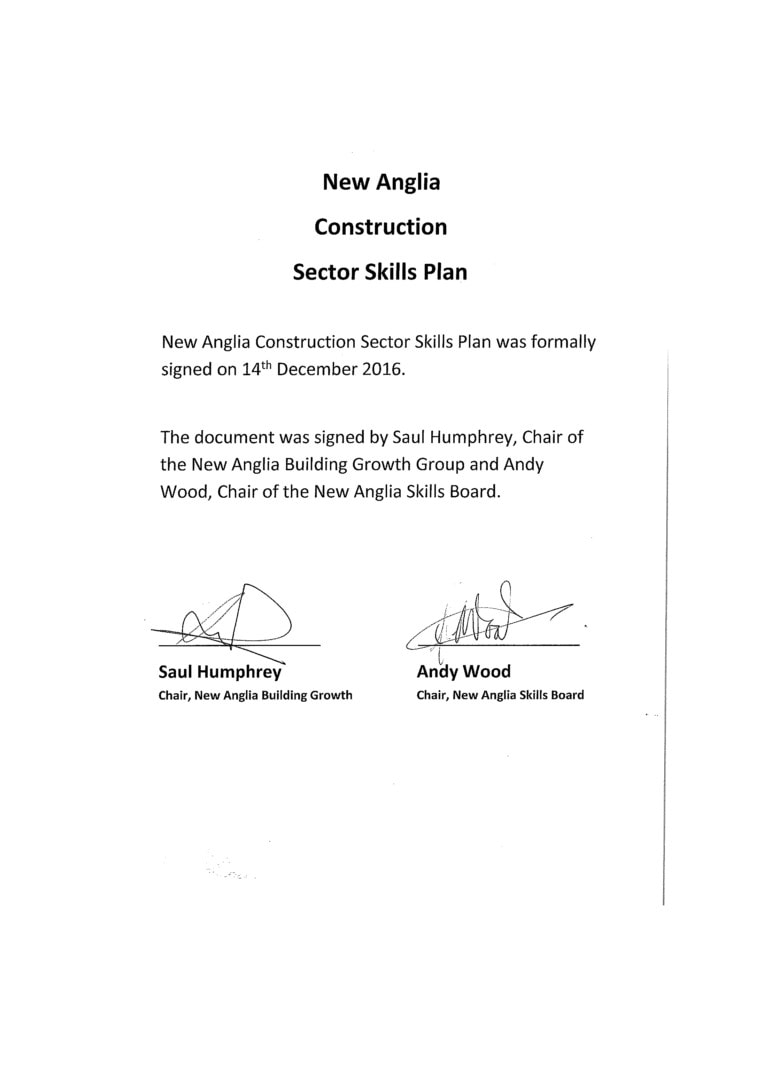New Anglia
Sector Skills Plan
Construction
A partnership plan aligning private and public resources to
jointly address the skills priorities of the construction
sector in Norfolk and Suffolk
September 2016
This plan is supported by the
‘New Anglia LEP Construction Labour and Skills’
Research Report provided by the CITB
1
A Skills Plan for New Anglia’s Construction Sector
The Construction Sector in New Anglia
The construction sector is a major component of New Anglia’s economy, accounting
for £2.4bn of GVA1 and with a workforce of over 59,0002 - many of whom are
working outside of Norfolk and Suffolk. There are around 7,370 construction
businesses with the overwhelming majority (93%) being micro sized companies with
less than 10 employees. It provides a greater proportion of our GVA (over 7%) than
the industry provides on average in other LEP areas making it integral to the health
and growth of our economy.
The Sector Skills Plan
This Sector Skills Plan (SSP) is an industry-led document developed by the New
Anglia Local Enterprise Partnership Building Growth Group in partnership with,
industry bodies, training providers and local authorities. It provides a framework for
aligning public and private sector investment in skills through mainstream funding
and locally delivered initiatives such as the New Anglia Skills Deals Programme and
Skills Support for the Workforce. It aims to highlight the skills priorities that need to
be addressed to support the sector’s growth ambitions and the LEP’s Strategic
Economic Plan to build 117,000 new houses, create 95,000 more jobs and 10,000
new businesses by 2026.
As with many sectors, reaching a universally accepted definition of the construction
sector is challenging. For the purposes of this plan, and to align with national
research, the construction sector is assessed as including the following functions:
•
Construction of buildings
•
Architectural and engineering activities
•
Civil Engineering
•
Specialised construction activities
•
Manufacture and retail of construction related goods
Forecast Growth and the Skills Need
Construction skills shortages are significantly affecting the delivery of projects across
the industry. After a prolonged downturn, in which the sector lost people and skills -
many of whom have not returned, it has recently experienced a period of significant
growth (grew more than any other sector in 20143) which has seen firms struggling
to find skilled labour in professional roles and manual trades. More than 400,000 UK
construction workers are expected to retire over the next five to ten years4 adding to
this crisis.
1 ONS/NOMIS 2014
2 ONS/NOMIS (2015) Annual Population Survey workplace analysis by industry Jan-14 to Dec-14
3 ONS 2016
4 19% (equivalent to 406,000 people) of UK construction workers aged 55+ are set to retire in the next 5-10 years. CITB, UK construction
industry facing skills ‘time bomb’, ugust 2013.
2
The impact of the recession was also felt by colleges, universities and other training
providers. With less demand many downsized their construction departments or
reduced their intake. Just over 5,300 construction and building services related
learning aims were delivered in New Anglia in 2014/15, a decline of 50 since
2012/13. The number of apprenticeship starts in construction related fields has also
fallen over the last few years. The proportion of overall apprenticeships starts in
construction related areas in New Anglia has fallen from 4.2% in 2011/12 to 3.6% in
2014/15 - a drop in real terms of almost 100 apprenticeship starts. This is compared
to 30% in health and public services, 25% in business and administration and 17% in
retail and commercial enterprise.5
The limited supply of skills has the potential to threaten the delivery of New Anglia’s
housing target and key infrastructure projects and has resulted in severe and
immediate skills shortages, rising wages and increased competition between firms.
82% of employers in the UK believe there is a skills shortage in the sector and that
this will slow down projects important for growth.6
The Construction Industry Trade Body (CITB) estimates that more than £5.4bn will be
invested in construction projects over the next four years. This is a conservative
estimate based on projects within the planning system, rather than a total forecast of
construction projects. It omits some nationally significant infrastructure projects and
some projects included may not go ahead or be subject to delay whilst new projects
are continually being created. The CITB also forecasts significant growth with 4260
jobs created every year for the next five years in the East of England.
Figure 1: Value of the construction sector in New Anglia 2015 - 20197
Infrastructure
Commercial
Housing
Industrial
Public
£1.748bn
£385m
£2.3bn
£230m
£762m
By project type housing represents the single largest sector in Norfolk and Suffolk,
with a total of £2.3bn expected to be delivered, the largest concentration of which will
be in Ipswich and Norwich and Kings Lynn. Public non-residential and infrastructure
activity also comprises significant parts of the total spend, the latter mostly owing to
offshore wind installations.
The CITB analysis estimates that the total labour demand for the construction sector
will rise from 93,250 people in 2015 to a peak of 98,700 people by 2019. This
includes significant demand for carpenters, general labourers, electricians, and
plumbing and heating engineers. This demand is expected to be further increased if
and when the work planned for Sizewell C Nuclear new build commences. It is
5 Skills Funding Agency LEP Datacube.
6 Skills in Construction, CIOB, 2013
7 CITB New Anglia LEP Construction Labour and Skills Research, February 2016
3
estimated that across the two counties the peak demand for the Sizewell project will
equate to almost 10% of the rest of the workload.8
To note. The potential impact of Brexit on these forecasts cannot be ignored although no new
modelling is currently available. If the impact is less immigration and less growth this could result in
less construction and less jobs. However, as there is already a skills shortage with future reductions in
the supply of labour expected, it would seem prudent to continue developing plans to meet this
current and future need.
Key Challenges and priorities
A steady supply of talent: The image of construction has long been a barrier to
attracting young people many of whom associate the industry with insecurity, difficult
working conditions and low pay. The pool of people employed in the industry
younger than 25 years old has shrunk significantly since 2008. Those aged 25 to 49
dropped 16% and those older than 50 fell by 8%.9 The sector is stereotyped as being
male and working class. Women make up just 13% of the workforce in New Anglia.
The construction sector offers a wide variety of roles in trades and professions and
clear progression paths. However, this is rarely showcased and there is not a
coordinated approach to debunking misperceptions or promoting the positive
aspects of working in the sector.
Boom and Bust: More so than in most other sectors, the construction sector has
historically endured a boom and bust cycle that many in the industry accept as an
intractable issue. This cyclical nature means that companies may adopt short-term
horizons that makes investing in people a difficult choice. Through the development
of the sector skills plan, solutions to help create a steadier demand for works were
discussed. Whilst initiatives were suggested to help ensure the demand for skills and
labour across the area is understood and therefore planned for, it was agreed that no
single solution was likely to solve this wicked problem but that the actions identified
to address other specific issues should be implemented with the intention of
mitigating the negative effects of boom and bust.
Improving Training Provision: The provision of training needs to be of the quantity,
quality and type to match the forecast need for skills in the sector. This includes the
training made available to the current workforce as well as the training of new
entrants for the sector. Barriers to achieving this include the capacity and resources
of businesses (the majority of which are small or micro businesses) to upskill their
workforce, the ability of training providers to recruit teachers and lecturers of a high
quality and the matching of training to the ever changing needs of the sector
resulting from such factors as the introduction of new methods and technology.
In order to help mitigate the effects of the cyclical nature of the industry the provision
of training that looks to provide a workforce with the skillset and flexibility to move
between sectors is also desirable.
8 CITB New Anglia LEP Construction Labour and Skills Research, February 2016.
9 CIOB, Face of Construction, 2014
4
Actions (details can be found in Annex A)
To help to address the key challenges identified above the following actions have
been agreed against three main priorities:
Provision - Training provision to match forecast need
We will pilot, develop and establish a work experience brokerage scheme
We will create and promote a New Anglia Construction Training Fund
We will establish an effective mechanism to identify and address specific skills
gaps in the sector
We will develop, pilot and establish a programme of pre-employment skills
training designed to enhance reskilling and conversion pathways into
construction.
Perception and Inspiration - Enhance sector image to increase volume and diversity
We will conduct an audit of existing communication and look to identify key
messages to be used consistently across organisations and platforms
We will place the construction sector at the forefront of the New Anglia Youth
Pledge
Meeting Demand - Plan to address the forecast growth in labour demand
We will establish a Building Growth Nuclear Forum to understand the wider
impact of Sizewell C on all planned construction projects.
5
Monitoring and Implementation
This plan is owned and overseen by the New Anglia Building Growth Group working
with the New Anglia Skills Board. Both groups have approved the plan. The New
Anglia Skills Board will look to support the implementation of this plan where
possible.
Progress on implementation will be reported up to the Building Growth Group
through a Skills Lead nominated by the Board. A LEP Skills Policy Officer will work
with the Skills Lead to help coordinate implementation of the whole programme of
activity.
Each action will be owned and led by an identified lead as described in more detail in
Annex A.
6
ANNEX A - Action Plan Details
PRIORITY 1
PROVISION: Training provision to match forecast need
Action 1
We will pilot, develop and establish a work experience brokerage scheme
Need
In order to improve the chances of securing employment at the end of any training period,
young people require experience of work and employability skills. There are challenges for
construction businesses taking on young people such as initial training needs and the costs
associated with the cyclical/project nature of the industry.
Description
A brokerage mechanism will be established to allow employers to access apprentices and
learners for paid work. The brokerage will address HR issues on the employers behalf and
work with learners to support their experience of work, addressing any employability concerns.
Initially this will be run as a pilot by City College Norwich as an expansion of their existing
catering brokerage. This will then be expanded through the college network. This work will be
overseen by the Employer and Training providers sub-group of Building Growth to allow best
practice to be shared.
A pilot looking at the underlying barriers to creating work experience placements in
construction has been delivered by Cheryl Willis of Suffolk Coastal and Waveney District
Councils. Lessons learned will be shared across Norfolk and Suffolk.
The New Anglia Youth Pledge is a separate priority in this Sector Skills Plan. This will also
increase the opportunities for work experience (see Priority 2 Action 2).
This action will contribute to the New Anglia Skills Manifesto by:
Encouraging and enabling more employers to get involved in better preparing young
Strategic Links
people for work.
Contributing to the New Anglia Youth Pledge to increase the number of opportunities
for young people including work experience and apprenticeships
Ownership and
Once established the Employer and Training Providers Building Growth Sub-Group will
Accountability
drive this work
Building Growth Group with support from the LEP and Local Authorities to coordinate
the establishing of this group.
Cheryl Willis (Economic Development Officer - East Suffolk) will share details of the
Lowestoft pilot to help encourage roll-out of similar approaches across the region.
Establish the Employer and Training Providers Building Growth Sub-Group
Initial Actions
Immediate
to oversee and lead this work.
Autumn/Winter
Roll-out Lowestoft pilot lessons to other areas
2016
Run brokerage pilots in construction via City College Norwich.
Early 2017
Expand access to existing HR and brokerage apps to other FE providers
2017/18
and employers.
Academic Year
Measures of
Development and roll-out of brokerage app to wide group of training providers
Success
Expansion of work experience pilot
Additional work experience opportunities created
Increase in apprenticeship starts in construction related fields
7
PRIORITY 1
PROVISION: Training provision to match forecast need
Action 2
We will create and promote a New Anglia Construction Training Fund
Need
To maximise the potential of employers across the region to upskill their workforce, the support
available must be made as prominent and accessible as possible. This will help ensure that the
right skills are available to help the construction industry grow and that standards are maintained
on site.
Description
Local funds such as the Employer Training Incentive Pilot, the New Anglia Skills Deals
Programme, grants from local training providers as well as sector specific support, such as funds
from the CITB, are available to help incentivise and enable employers to provide development
opportunities for their workforce. Actions will be taken to enhance and increase the visibility of
these schemes. Some funding programmes are due to end in March 2017 but this will be an
ongoing commitment covering all funds that are available at any given time related to the sector.
A ‘New Anglia Construction Training Fund’ will be established as an umbrella brand
under which will sit the various support products available. This will help ensure
employers are aware of the funding that is available to them by promoting existing
schemes.
Opportunities will be explored to create a support programme specifically for the
construction industry by ring-fencing and blending some of the funds available in order
to provide the support required that falls outside of the remit of the current schemes.
Opportunities to link funding to finance individual projects will be explored. Project ideas may be
sourced from various groups such as the Building Growth Group. The Employers and Providers
sub-group of the board, which will be looking at gaps in current and future provision (please see
Priority 1, Action 3), will be a further possible source of ideas.
This action builds on and enhances the reach of the funding already made available to the sector
for skills needs and tailors it to maximise the benefit to the construction sector.
This action will contribute to the New Anglia Skills Manifesto by:
Strategic Links
Aligning collective effort to meet the skills needs of the sector
Developing better ways of supporting employers to invest more and reap the benefits of
upskilling their workforce
Identifying and nurturing management and leadership talent
Ownership and
Michael Gray, Senior Skills Policy Officer at Suffolk County Council will lead discussions between
Accountability
the New Anglia LEP, the Local Authorities, the CITB, training providers and other stakeholders.
Agreement to be reached between stakeholders on the brand and remit of the
Initial Actions
Autumn 2016
New Anglia Construction Training Fund.
The need to merge funding into a new programme for the construction sector
Autumn 2016
and the potential to do so to be explored.
Winter 2016 /
Promotion of the New Anglia Construction Training Fund
Spring 2017
Measures of
Establishment of the New Anglia Construction Training Fund
Success
Additional take-up of support by the construction sector
Additional number of businesses providing development opportunities for their workforce.
Development of additional skills projects for the construction sector
8
PRIORITY 1
PROVISION: Training provision to match forecast need
We will establish an effective mechanism to identify and address specific skills gaps
Action 3
in the sector
Need
There is a need to adapt provision to current and future need to ensure we have the right
skills at the right time for the industry to flourish.
Description
The Employer and Training Providers Sub-Group will look to identify gaps in the current
system including provision for specific skills needs and hard to fill vacancies. Provision will
be driven through close collaboration with existing providers and a programme of wider
engagement with other construction sector groups. Opportunities such as the Skills Deals
Programme will be explored.
Immediate action will be taken where gaps or needs have already been identified. For
example due to an aging workforce and competition for quality candidates from the higher-
paid private sector, public sector planning has an emerging skills gap. Part of the proposed
solution is to pilot a new public sector apprenticeship scheme across local authorities in
Suffolk. Further conversations to take place as to rolling out the approach into Norfolk and
across the whole New Anglia region.
Both the New Anglia Skills Board and the Building Growth Group have an objective to help
link provision to the needs of the local economy. This action will build on and enhance the
work that these Boards oversee by providing a mechanism to identify needs.
This action will contribute to the New Anglia Skills Manifesto by:
Supporting employers to better communicate their current and future skills needs
Strategic Links
to schools, training providers, colleges, universities and Government.
Identifying specific skills gaps in our growth sectors and aligning our collective
effort to meet these challenges.
Ensure there are clear and complete training pathways for each sector that enable
people to get into and progress within their chosen career, and develop the higher
skill levels needed.
Ownership and
Once established the Employer and Training Providers Building Growth Sub-Group
Accountability
will drive this work
Building Growth Group with support from the LEP and Local Authorities to
coordinate the establishing of this group.
Suffolk County Council are progressing the work to address the planning skills gap.
Further project leads will be identified as needs are identified by the Employer and
Providers Sub-Group.
Public sector planning technician apprenticeship scheme advertised
Summer 2016
Initial Actions
September
First meeting of the Employers and Providers Sub-Group
2016
First planning technician apprenticeship cohort to start
October 2016
Share initial findings of skills needs and ‘hard to fill’ vacancies with
Early 2017
Building Growth Group and other employer forums.
Evaluate impact of Suffolk planning technician apprenticeship scheme
Mid 2017
and roll-out with Norfolk
Measures of Success
Identification of specific skills gaps and ‘hard to fill’ vacancies which is tested with
and confirmed by the employers groups.
The need for new provision identified and solutions developed and delivered.
Creation of provision identified as needed by employers - especially high level
qualifications including apprenticeships
Funding allocated to Skills Deals projects.
9
PRIORITY 1
PROVISION: Training provision to match forecast need
We will develop, pilot and establish a programme of pre-employment skills training designed
Action 4
to enhance reskilling and conversion pathways into construction.
Need
The CITB report suggests there is a shortage of skilled workers for both current and future sector
needs. In order to address this shortage we will need to do more than simply attract and train those
currently in education. Reskilling and cross-sector pathways should also be explored.
Current barriers to reskilling include:
Trainees may not have essential paperwork important for employment (eg. CSCS cards)
Trainees may need additional technical, English and Maths competence and softer skill
support to be job ready.
Employing a “hard to reach” trainee is seen as a risk eg quality of work, attitude and risks of
employing ex-offenders.
Employers may be unable to pay a “fair” wage to higher risk trainees initially requiring
additional support and supervision although trainees need to earn sufficient wage to support
themselves and rebuild their lives.
Areas of construction industry need sub-contractors rather than employees which may be
harder for “hard to reach” trainees to adapt to.
Description
A Building Growth Reskilling Sub-Group will be established to explore how cross-sector pathways
and reskilling can be used by engaging more employers to work with non-traditional recruitment
sources including local agencies and social enterprises.
The Reskilling Sub-Group will aim to develop and deliver targeted pre-employment skills training
including certification essential for employment together with appropriate support. Applicants likely to
be invited from a wide range of “hard to reach” backgrounds. Applicants to be assessed on their
ability to succeed in permanent employment with age not being a barrier. The ambition is to develop
a 2 year pilot programme which, if successful, would then be rolled out taking into account any
lessons learnt.
Details, results and lesson learned from the pilot will be shared widely with the NALEP Principals
Group, the Building Growth Group, Skills Board, New Anglia Learning Providers Group and other
construction groups and forums eg Norfolk Constructing Excellence.
This action will contribute to the New Anglia Skills Manifesto by:
Supporting employers to better communicate their current and future skills needs to schools,
training providers, colleges, universities and Government.
Strategic
Links
Identifying specific skills gaps in our growth sectors and aligning our collective effort to meet
these challenges.
Ensure there are clear and complete training pathways for each sector that enable people to
get into and progress within their chosen career, and develop the higher skill levels needed.
Ownership
Project co-ordination to be led by Reskilling Sub-group of Building Growth Skills Group.
and
Building Growth Group to establish this group through Christina Sadler.
Accountability
Activity will require involvement from key stakeholders including but not limited to the LEP,
Local Authorities, New Anglia Colleges, VETS East, Norfolk and Suffolk Police and Crime
Commissioners, HMP Norwich, Britannia Enterprises and DWP.
September
Initial Actions
First meeting of the Reskilling Sub-Group
2016
Project Delivery Plan to be agreed
October 2016
Potential pilot project with Easton & Otley College to developed and launched
January 2017
Potential pilot project with West Suffolk College focused on military veterans
January 2017
developed and launched
Pilot to be completed
July 2018
10
Measures of
Number of “hard to reach” individuals in Norfolk and Suffolk engaged by the pilot projects.
Success
Number of trainees assisted into permanent employment or self-employment as a result of
this activity.
Number of veterans successfully trained, supported and placed into employment within the
construction industry (including as construction lecturers).
Number of additional construction employers employing re-skilled individuals
PERCEPTION & INSPIRATION : Enhance sector image to increase volume and
PRIORITY 2
diversity
We will conduct an audit of existing communication and look to identify key messages to be
Action 1
used consistently across organisations and platforms.
Need
The construction sector offers a wide variety of roles in trades and professions and clear
progression paths. However, this is rarely showcased and there is not a coordinated
approach to debunking misperceptions or promoting the positive aspects of working in the
sector.
Description
An audit of existing communication platforms and careers guidance will be undertaken to
identify 3 key messages that should be used to promote the sector.
Work across stakeholders will be undertaken to establish these messages as consistent
across all media and platforms.
Promotion of these messages on platforms such as ICANBEA and ‘Go Construct’ will be
undertaken as well as increasing employer involvement on these platforms. Members of
the Building Growth Network will be encouraged to support the ICANBEA website as an
opportunity to promote their business and career opportunities.
The ‘East Prospectus’ currently being developed by NALEP to promote the image of the
East (Norfolk and Suffolk) will be used in conjunction with key messages to develop the
Building Growth communications and website to promote opportunities, for those
considering a career in construction, reskilling into the sector or relocating to the area.
By undertaking this work we will gain an understanding of where best practice exists and
share this across platforms. This will include a look at:
•
Stereotypes of the industry, around gender and low skills
•
Career routes into the sector and diversity of opportunities, focusing on skills
shortages and needs identified in the CITB research report
•
Promotion of Norfolk and Suffolk as a destination to train and work in.
This action will contribute to the New Anglia Skills Manifesto by:
Ensuring that all young people have access to the information they need to make
Strategic Links
informed decisions about their future.
Supporting employers to better communicate their current and future skills needs to
schools, training providers, colleges, universities and government.
Showcasing the local economy to young people and their advisers.
Ownership and
Work will be undertaken by Clare Dyble - Eason and Otley College, Director of
Accountability
Marketing and Enterprise
Work will be reported into the Building Growth Group who will oversee delivery.
Development of Building Growth website to promote sector and
Initial Actions
opportunities and signpost to relevant sources of information and
Immediate
guidance.
Audit of existing messages and advice
Jan 2017
11
Focus groups with schools and career advisers on perceptions
Jan 2017
Development of 3 key messages
Spring 2017
Influence across communication platforms and careers advice to
Ongoing
promote messages.
From Spring
Use of joint materials across stakeholders
2017
Measures of Success
Greater connectedness between the various platforms and sources of information
established.
Key messages prominent across platforms
Key messages understood and informing the opinions of young people and
advisers
Increased uptake in construction training across providers including higher level
qualifications
Reducing the gap between supply and demand for skills provision
PERCEPTION & INSPIRATION : Enhance sector image to increase volume and
PRIORITY 2
diversity
Action 2
We will place the construction sector at the forefront of the New Anglia Youth Pledge
Description
The New Anglia Youth Pledge Marque provides a further opportunity to enhance
perceptions about the opportunities for new entrants into the sector.
The Building Growth Group network will promote the New Anglia Youth Pledge Marque and
set targets for sign up. Through the group this opportunity will be promoted to the wider
construction network.
The Enterprise Advisor Network is one of the main components of the Pledge Marque. This
will be promoted and individuals encouraged to sign up as a way of changing perceptions
in schools around construction careers and the opportunities that exist such as removing
the stereotypes around diversity and low skilled opportunities. The Enterprise Advisor role
allows for strategic input to individual schools, allowing promotion and shaping of careers
provision, as well as business links to raise aspirations and widen the views of
opportunities available.
This action will contribute to the New Anglia Skills Manifesto by:
Ensuring that all young people have access to the information they need to make
informed decisions about their future.
Strategic Links
Supporting employers to better communicate their current and future skills needs to
schools, colleges, training providers, universities and government.
Showcasing the local economy to young people and their advisers.
Ownership and
Building Growth Group to work with the Skills Board to encourage involvement
Accountability
from the sector.
From
Initial Actions
Pledge Marque promotion at Building Growth meetings to increase
September
uptake and for wider sharing in networks. Targets to be set.
2016
Construction sector pledge marque case studies to be developed so they
October 2016
can be promoted
Measures of Success
High proportion of employers in the construction sector signed up to the Youth
Pledge Marque.
Increase in the amount of construction sector Enterprise Advisers.
Construction one of the most prominent sectors engaged in the Youth Pledge
Marque.
12
PRIORITY 3
MEETING DEMAND : Plan to address the forecast growth in labour demand
We will establish a Building Growth Nuclear Forum to understand the wider impact of
Action 1
Sizewell C on all planned construction projects.
Need
The Sizewell C development will have an impact on other construction projects within the
region. The need for this forum is to share information and develop an action plan to allow
the construction sector to be better placed to plan for the changes in demand, rather than
having to react as the impact is felt.
Understanding the challenges and demand that the Sizewell C project will place on the
area will help shape the provision priority above, as well as inform any key messages or
marketing collateral produced by the Building Growth group.
Description
The formation of the Building Growth Nuclear Forum builds on the experience from the
Hinkley Nuclear Project. A group will look at the lessons learned from Hinkley and use this
to establish a forum to focus on the skills impact from the proposed Sizewell C
development and the wider impact on other construction projects in the area.
It is proposed that EDF takes a lead on this group to assist with the lessons learned from
Hinkley.
There are a number of other groups that exist related to construction and energy skills such
as the Suffolk Energy Coast Skills Sub-group. This forum is not meant to duplicate these
groups, but bring together key people to identify strategies that are already happening, and
enhance these, as well as identify areas which need new provision or strategies. This
forum, through its make-up, will ensure linkages to the other sector skills plan priorities. As
and when necessary, and as is the nature of a forum, other key personal will join or leave
the group as appropriate to provide input and linkages. However, there will continue to be
Strategic Links
a key lead in Tom McGarry and representatives of the Building Growth Group who will
ensure linkages to the wider landscape.
This action will contribute to the New Anglia Skills Manifesto by:
Supporting employers to better communicate their current and future skills needs to
schools, training providers, colleges, universities and government.
Identifying skills shortages and aligning collective effort to meet these challenges.
Ownership and
Tom McGarry - Head of Communications, Sizewell C will look to establish the forum and
Accountability
report into the Building Growth Group.
EDF share lessons learnt, including the proposal to integrate the Skills
Initial Actions
TBC
Strategy and Employer Strategy into one combined proposal
Meetings to be set up quarterly to share best practice, increasing as
TBC
momentum on the project increases.
Measures of Success
Greater understanding of the flow of labour required during the project to better
respond to the project demands
Increased supply of labour to predominately come from Norfolk and Suffolk without
impacting on the supply of labour to other construction projects.
13













